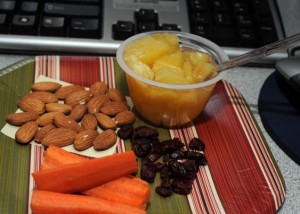
Whatever job you’re in, you’ve probably experienced the notorious mid-afternoon slump: that moment at work when your brain, body or both seem to decide that they’ve had enough. Could your choice of lunch be playing a part in your lack of energy and could changing what you eat help avoid it?
We spoke to Edinburgh Accies rugby club’s nutritionist Tess Capper and to Gillian Reith, co-owner (along with her sisters Linsey and Nichola) of Three Sisters Bake café and craft boutique in Quarriers Village, to find out more.
It’s a subject that Gillian herself is all too familiar with, admitting that she and her sisters, “very often find ourselves hitting a wall of tiredness at 3pm in the Three Sisters Bake office!”
If the slump is a real thing though, are we right to think that our choice of lunch at work may be exacerbating it or even causing it? It would seem so. As Tess says, “We dip in the afternoon not only because our brains become tired, but because our blood sugar levels reach a low point following lunch.”
The good news is that not only is Tess able to diagnose the causes of the slump, she’s also able to tell us how we can avoid it. “Adding more low-fat and unprocessed protein to our lunches helps by keeping us fuller for longer, as would aiming when possible for low GI carbohydrates to release energy slowly and consistently throughout the afternoon. Snacking can be very good for us when done right, preparing ahead and opting for fruit and nuts, for example, rather than heading for the vending machine.”
For many of us though, it can be preparing ahead that is the daunting part of eating healthily at work. Thankfully, Gillian has some handy advice on putting together a packed lunch. “I would always do it at the same time as dinner preparations the night before, trying to get out of bed ten minutes early to make a packed lunch will definitely turn it into a chore! Planning your packed lunches for the week with a shopping list is also a good idea, that way you can make sure you have all the ingredients in the house ready to go.”
If you do slip up though and find yourself needing to nip out for lunch, all is still not lost as Gillian has a suggestion for a healthy but filling combination – “I tend to grab a cup of soup with some oatcakes and houmous, really quick but it provides loads of energy.”
Just how much energy should we be looking to take on board at lunchtime though? The answer lies in the nature of the job that we have, as Tess explains. “I think it goes without saying that someone who is consistently active throughout the day should have a higher energy intake than someone who is sedentary.”
“Carbohydrates should be used or earned, i.e. consumed before or after a workout or to fuel an active worker in the morning and afternoon. Sitting at a desk all day does not require a carbohydrate-heavy breakfast or bread-based lunch. Maintaining a healthy weight requires the balance of energy in and energy out and the diets of workers should be tailored to their energy output during the day.”

Whether you work at a desk or spend your day on the go though, Tess has advice on how to keep your energy levels up. “My tips for both groups are to go homemade whenever possible. Preparing lunches and snacks saves money and allows you to be sure of exactly what is going into your lunch. Sedentary office workers should aim for a more protein and healthy fat-rich lunch while active workers can add some slow-release carbohydrates in there to fuel their afternoon. If the lunchtime sandwich run is the only option, aim for brown or wholemeal bread, no mayo and chicken or tuna over high-fat and salt processed meats.”
So far we’ve focused on how employees should be thinking about lunchtimes but is it something that employers should be aware of too? Tess certainly agrees. “I believe more and more now that nutrition in the workplace should have a little bit more attention. This mid-afternoon slump is a low-productivity period that can be avoided with a more balanced lunch and in workplaces where food is available, employers can look into ensuring that their employees are getting the right foods to fuel their brains and bodies.
“Overall health can be improved with the addition of more vitamins, minerals and antioxidants to the diet, which will make the immune system stronger and better at fighting the nasties that often circulate offices in the winter. Having a healthier diet will also make us more able to bounce back from illness quickly, hopefully meaning less sick days.”

So the message is that if you still want to be bright-eyed and bushy tailed after 3pm, a healthy packed lunch is the way to go. Meanwhile, employers might want to keep the fruit bowl stocked. An apple a day could keep the sick leave away!
Fruit photo – U.S. Air Force photo by Airman 1st Class Klynne Pearl Serrano used under Wikimedia creative commons agreement



I quite like reading an article that can make people think.
Also, thank you for allowing me to comment!